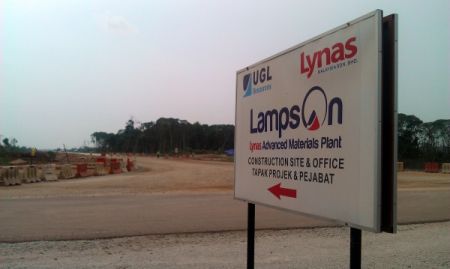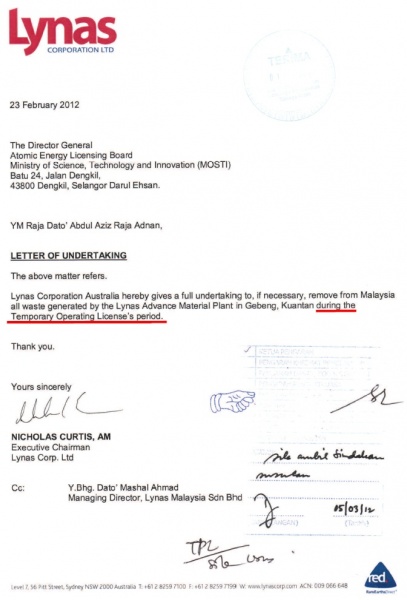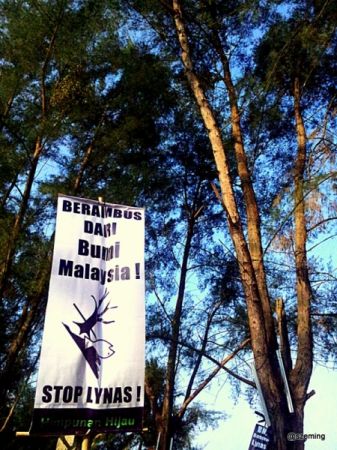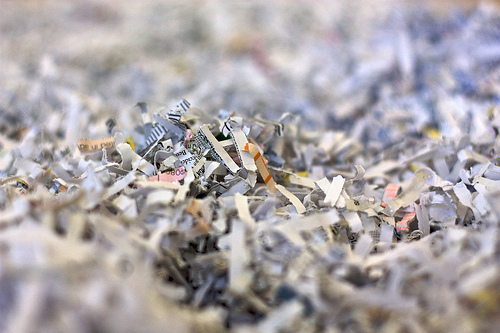After the dust from the Parliamentary Select Committee (PSC) report on the Lynas Advanced Materials Plant (LAMP) has settled, it is clear to all that it is merely a public relations attempt by the government to whitewash the project. The rakyat is not surprised by the government’s betrayal; after all, Lynas themselves acknowledged in their quarterly report for the period ending 31 March 2012 “that the main purpose of the PSC is to continue to help raise awareness concerning the LAMP.” [1]

Below are some of the objectionable points from the report:
1. Lynas’ letter of undertaking to ship the waste out of the country is reproduced in the PSC report (see figure). According to the letter, Lynas only agrees to ship out the waste generated during the 2-year Temporary Operating License (TOL) period, not the entire 20 years for which LAMP is projected to be in operation, which is what the public is made to believe [2].

2. The PSC recommends that the TOL be issued to Lynas. Ironically, in the same report, further studies are also recommended. These studies are:
a) a health baseline study
b) a Health Impact Assessment (HIA)
c) an epidemiological study to determine if there is a link between the leukemia and cancer cases in Bukit Merah and the Asian Rare Earth (ARE) plant.
It is irresponsible for the government not to compel Lynas to complete these studies first before allowing Lynas to commence operation. In view of the doubts surrounding the safety of the project, all studies must be done a priori, and most certainly before the TOL is issued!
3. The argument that the DEIA (Detailed Environmental Impact Assessment) is the same as the PEIA (Preliminary Environmental Impact Assessment) is simply flawed. The fact that a HIA is recommended implies that the PEIA is incomplete. Furthermore, public consultation, absent in the PEIA, would certainly be a part of a DEIA. Another fundamental difference is that the DEIA is conducted by the federal government, and the terms of reference determined by the federal authority, which must include a HIA and a referendum now. Incidentally, the committee also reported 8 weaknesses in the PEIA and these must be addressed with a DEIA.
4. The government demonstrated its sheer incompetence in admitting that they do not have a clue about what happened in Bukit Merah. The government had 20 long years to investigate the complaints of the Bukit Merah residents, and yet they did nothing. We are shocked that the government views so lightly an environmental disaster that took USD100 million to fix and required another 300 years of supervision by the state government. Don’t blame the public for doubting the competence of the authorities to regulate the largest rare earth refinery in the world.
5. The PSC report states that the risk from internal emitters have been taken into account. Lynas computed this risk using the ICRP method, which dilutes the waste to the entire mass of the body. This model is flawed because radiation exposure from embedded radioactive particles is localized. Prof Chan Chee Khoon presented evidence where the ICRP model failed to explain high instances of cancer near nuclear power facilities [3]. Furthermore, a well-known proponent of this argument, Chris Busby, believes that the actual risk from LAMP may exceed IAEA’s own limits [4].
6. The report revealed that the license to construct the factory from MITI was approved (22 Jan 2008) before the PEIA was approved (15 Feb 2008). Does this mean that even MITI was not even aware that the PEIA was horribly skewed in favor of the exaggerated economic benefits over environmental considerations [5]? Another evidence of incompetence, or perhaps bribery [6][7]?
7. Lynas has not been truthful in stating that they were not rejected by Terengganu. Lynas has always claimed that they relocated to Gebeng because they got impatient waiting for the approval from the state government [8]. By Lynas’ own admission in their 2007 Q4 quarterly report, the tax holiday is extended from 10 years to 12 years to compensate for delay caused by the relocation [2][9]. The Ministry of Finance website further revealed that “pioneer status” typically comes in increments of 5 years, there is strangely no category for 12 years [10], thus lending weight to the argument that the extra two years is the result of Terengganu’s rejection.
8. The committee recommends better public engagement and transparency, yet does not compel Lynas to disclose these important documents. They are:
a) The plant decommissioning plan (to meet IAEA recommendation 2) or more specifically: “Environ Consulting Services (M) Sdn Bhd (2011b): Decommissioning Plan for the Advanced Materials Plant, Gebeng Industrial Estate, Kuantan”,
b) The updated RIA (to meet IAEA recommendation 1 and 2), and
c) Test results of the structural integrity of the plant.

9. Cherry-picked facts favorable to Lynas and blatant lies are used to steer the report toward the desired conclusion: Lynas is safe. For example:
a) The report compares Lynas to other rare earth projects, namely Ashton and Arafura, but hides the fact that these projects are subjected to stringent environmental regulations. The two most glaring differences are that no waste water discharged and no accumulation of waste are allowed at the refinery. Extensive public consultations were also held for both projects, unlike LAMP which crept up overnight on the Malaysian public [2].
b) The report states that Stop Lynas Coalition’s (SLC’s) application for leave to challenge the legality of the TOL was denied. However, it fails to disclose that the Judge Rohana Yusuf denied leave not because the case had no merit, but because it was filed prematurely. In fact, she ruled that the approval of the TOL “is a decision amenable to judicial review” in view of the evidence presented [11]. An appeal has been filed and a hearing date is being sought.
c) Lynas has not been truthful when they claim that LAMP operates under atmospheric temperature in their presentation slides. In the “cracking” process, the ore concentrate from Australia is roasted at 650°C for 2.5 hours. Within the Chemical Engineering community, this temperature is regarded as “extreme temperature” [2].
d) The AELB has on numerous occasions used UNSCEAR 2010 to justify that there is no link between low-level radiation exposures to cancer. Although UNSCEAR 2010 found no conclusive link, they admitted that the study is hampered by “the lack of specificity in the type or characteristics of disease induced by radiation exposure, the long delay (years or decades) between exposure and disease presentation and the high spontaneous incidence of diseases associated with radiation in the ageing general population.” Furthermore, the paper states “there is emerging evidence from recent epidemiological studies indicating elevated risks of non-cancer diseases below doses of 1 to 2 Gy, and in some cases lower.” [2][12]
“If you prick us, do we not bleed? If you tickle us, do we not laugh?
If you poison us, do we not die? If you wrong us, do we not fight?”
– Mr Tan Chin Hua
Acknowledgements: Soo Jin Hou (Stop Lynas Coalition), Tan Sek Choong (Feature Writer of MerdekaReview)
References:
[1] “Quarterly report for the period ending 31 March 2012”, 30 April 2012, Lynas Corporation. From http://www.asx.com.au/asxpdf/20120430/pdf/425x3s90k6yftx.pdf
[2] “???????????, ???????????”, 20 June 2012, Tan Sek Choong, Merdeka Review. From http://www.merdekareview.com/news_v2.php?n=25350
[3] “Lynas: the use and abuse of science”, 23 June 2012, Chan Chee Khoon, The Malaysian Insider. From http://www.themalaysianinsider.com/sideviews/article/lynas-the-use-and-abuse-of-science-chan-chee-khoon/
[4] “Claims of safety for Lynas plant is based on selective science”, 24 May 2012, Soo Jin Hou. From http://wangsamajuformalaysia.blogspot.com/2012/05/claims-of-safety-for-lynas-plant-is.html
[5] “Environment given short shrift in Lynas plant study”, 25 April 2011, Joseph Sipalan, Malaysiakini. From http://www.malaysiakini.com/news/162398
[6] “Now that Bersih is over (part 2)”, 2 May 2012, Raja Petra Kamarudin, Malaysia Today. From http://www.malaysia-today.net/mtcolumns/49078-now-that-bersih-is-over-part-2
[7] “Lynas says paid Putrajaya for toxic waste cover”, 21 May 2011, Debra Chong, Malaysian Insider. From http://www.themalaysianinsider.com/malaysia/article/lynas-says-paid-putrajaya-for-toxic-waste-cover
[8] “Lynas denies being ‘chased away’ from precious sites”, 19 April 2012, Shannon Teoh, Malaysian Insider. From http://www.themalaysianinsider.com/malaysia/article/lynas-denies-being-chased-away-from-previous-sites/
[9] ” Quarterly report for the period ending 31 December 2007”, Lynas Corporation. From http://www.lynascorp.com/content/upload/files/Reports/Q4_2007_Final_Version_Revised_1.2.08.pdf
[10] “Pioneer Status (PS)”. From http://www.treasury.gov.my/index.php?option=com_content&view=article&id=704&Itemid=201&lang=en
[11] “Lynas: Judgement dismissing leave for judicial review”, 12 April 2012, Rohana Yusuf. From https://www.loyarburok.com/2012/04/17/lynas-judgment-dismissing-leave-judicial-review/
[12] “Report of the United Nations Scientific Committee on the Effects of Atomic Radiation 2010”. From http://www.unscear.org/docs/reports/2010/UNSCEAR_2010_Report_M.pdf


thanks for sharing
Great post you think of. My mind got you fully. I felt your mind with this post. Great style of
writing. Go for big. Thanks!
As an engineer, I do believe that a RE plant can be managed well enough to be safe. Theoratically you can argue how safe the plant is, and the argument is valid. But I'm still against the Lynas project for a few reasons. Malaysia is notorious for building 1st class infrastructures, but when it comes to implementation/operation/maintenance we are the worst. Bukit Merah is a good example. You can argue to have independent evaluation of the safety of the plant while it's in operation. All of us know, these reports can be tainted and biased. Again, Bukit Merah is a good example. Most importantly, I'm against Lynas because bringing in a FDI like Lynas is business. The 2 most important factors to a business is it's risk and profit. My judgement on LAMP is high risk (taking into consideration of its wastes, operations, the need of human factors to operate safely, and others), but why aren't we getting high profits from this deal? Many other countries are rejecting RE plants, but we invite them with a 12 years tax holiday.
Dexter. You may be an engineer but you do not read widely. You are mistaken other countries are rejecting RE plants because if you do a very simple Google search, you will find there is now a rush to built RE plants in Western countries. Engineer should deal with facts and not fictions.
Talk kok king that's who you are. All upcoming western RE plants are developed with robust permanent waste management plan in place. That includes Mountain Pass mine developed by Molycorp and Nolans Bore developed by Arafura. All require radioactive wastes to be RETURNED TO THE MINING SITE FOR PERMANENT BURIAL. Oh btw, Lynas is still trying to figure out what to do with their radioactive wastes. Real engineers will design a toilet with the house, not figure out where to put the toilet AFTER the house is built.
Nice!
I am a member of the Natural Resources Defense Council since 1972 and the Molycorps Rare earths plant operating here in California has proven through tests that they can with newer advanced technologies operate clearly under strict environmental watch by independent organizations. Lynas can do the same in Malaysia.
Environmentalists have a interest in rare earths because they are needed to manufacture wind turbines, electric cars, cell phone batteries, low energy consumption reducing drastically our need for coal and oil burning which release Uranium ash in the air we breathe. These fossil fuels burn upwards of 2000 degrees Centigrade yet none question this! TOL stands for Temporary Operating Licence which means Lynas will be shut down if any breeches occur. Lynas can prove safety only if they are in operation. The environmentalists of Malaysia should press for independent evaluation of this safety while the plant operates under the TOL.
Yeah… Molycorp is certainly relatively safe. Molycorp practices zero waste water discharge, all waste water is evaporated. In contrast, Lynas plans to dump 500 tons of water per hour into the South China Sea. Furthermore, Molycorp bury the waste deep in the Mountain Pass desert in lead-lined chambers, Lynas will be dumping their shit in landfill type waste disposal site. Before they figure out where the permanent disposal site is, Lynas will be dumping their shit in Gebeng, where 700,000 people live within a 35 km radius. Lynas the same as Molycorp? Haha… you gotta be shitting me.
Thorium radiation is made of alpha particles which cannot penetrate through human skin, it is moderately harmful when swallowed. It can be held in our hands with thin vinyl gloves so it does not mix in our body fluid. Even the more radioactive Uranium can be handled in this way. Enriched Uranium used in nuclear reactors goes into fusion and produces Plutonium 239, the most radioactive element. This cannot be handled because it produces gamma rays that penetrate through everything, even through thick lead shields it is biologically very dangerous. Fukushima used a Plutonium reactor(a very stupid idea) and 4 Uranium reactors. The half life of Plutonim239 is 24,000 years, the half life of thorium232 which is found in everyone's garden everywhere is 14 billion years. Thorium decays 583,333 times slower than Plutonium and inversely Plutonium 583,333 times faster, that is why it is so dangerous.
More idiotic comments from Lynas' trolls. Its fine when its outside the body. But when inside the body, alpha particles do 20 times more harm than alpha or gamma radiation. Moderately harmful? Haha… you gotta be shitting me. That's 20 times more harmful you idiot.
Processing rare earths can be done cleanly. Lynas has the technology to recycle the water used and separate the thorium, the water is brought back to drinking standard and reused by the plant. There is no plan to release water in the river.
"There is no plan to release water in the river. "
Are you an idiot? The PEIA clearly states that the eflluent will be discharged from the plant at a rate of between 330 m3/hr and 500 m3/hr in page 2-15. That's 500 tons per hour by the way.
What I wonder is: where were the opponents of Lynas in 2007 before the Lynas Advanced Materials Plant was built? There was a public environmental review process that took a year. Then the plant was slowly built over 4 years. It was not built in a closet but on a huge parcel of industrial land in full view of everyone. Why did the opponents chose to act in the Summer of 2011? Some people are obviously sincere but most are in a state of fear fanned by Opposition politicians who need an issue to become famous and elected. Cherry picking is done by all siding the issue.
There was no public consultation you dumbass. Unlike Arafura and Ashton projects where extensive public consultation was held, the Lynas project crept up on Malaysians overnight through an article in the New York Times. Why do you think people are opposed to the plant? Imagine a stranger taking a shit in your living room without your permission.
JinHou. This article condemn public awareness of Lynas and I quote “that the main purpose of the PSC is to continue to help raise awareness concerning the LAMP”. Isn't raising public awareness a good thing? Why doesn't Anti-Lynas want more public awareness?
From a Malaysia Insider report, Lynas was first raised in the Pahang state assembly in 2008 and PKR raised no objection nothing. She only raise objection in 2011. Instead a lone MCA assembly man did raise concern of health in 2008. So there is no 'overnight' issue like you said.
Your comment betrays your ignorance.
The primary reason the opposition members boycotted the PSC is because the PSC has no power over the fate of the plant, i.e. it has no power to make decision, i.e. it is just a public relation exercise. The question is not whether public awareness is a good thing, the question is whether the PSC is just a ploy to whitewash the Lynas project. If it is the latter, which is confirmed by Lynas' quarterly report, it is a betrayal of the interests of Malaysians. This point is raised to address the accusation by Lynas trolls that the opposition boycotted the PSC because they are only interested to politicize the issue. Nothing is further than the truth, would anyone want to spend months researching something, to know that at the end of the day, it won't matter?
I presume you refer to Fuziah when you said she. You are a big fat liar if that is so. Fuziah brought it up in Parliament as soon as she got into office. And she's a MP, not an ADUN, so she doesn't sit in the state assembly. Get your facts right.
You are just looking for excuses and is the truly ignorant one. You did not know that Anti-Lynas and her Pakatan backer will avoid ALL events or hearing or public forum whereby one need to present real solid science. It does not matter whether it is policy making or for educating the public. The reason is very simple, because their scientific objection are all fake and can not stand up to peer review.
Here's a proof. In 7-May-2012, Anti-Lynas and Pakatan were invited to be panelist on a rare earth symposium that is OPEN TO THE PUBLIC but they all declined. They do not want to tell the PUBLIC the real facts about Lynas based on REAL science because many of the things they said have no scientific basis. http://www.akademisains.gov.my/download/rareearth… earth symp.pdf
As for Fuziah. You are again ignorant beyond any doubt. She knew about Lynas in 2008 and said nothing. You do know in 2008, Lynas hasn't been built, right? She only object in 2011. When this was pointed out to her, she now kept more quiet. Here's a link for you in a Pakatan friendly news. javascript: IDsaveComment(566763193) ;http://www.themalaysianinsider.com/malaysia/article/mca-warns-kuantan-mp-to-cease-attacks-over-lynas/
Stupid as stupid gets. U r quoting from ti lian ker from MCA, who loves to criticize but chicken out when invited to debate. Fuziah lost twice before elected to parliament on 2008, so pray tell me how the heck she got into the state assembly? Pakatan avoiding events? haha. Fuziah took up the challenge to a public debate against aelb director raja aziz. Guess what? The show was pulled. Seems like it's the pro-lynas side that's running scared.
Why did Fuziah turn down being a panelist on a public educational forum on rare earth? She didn't want to tell the general public the real truth? Or she didn't dare to repeat her nonsense science in front of REAL scientist? How much is she paying you? http://www.akademisains.gov.my/download/rareearth… earth symp.pdf
Your stupidity is getting annoying. First of all, I don't know and I don't care whether she turn down any government sponsored event, since its quite pointless to participate in any events if the government decides to censor anyway, as evidenced by the termination of airing of the debate between Fuziah vs Raja Aziz on TV1, of which the audio recording is uploaded to youtube as proof of censorship. Secondly, only dumb shit like you regard the Malaysian Academy of Sciences as "real" scientists. Why don't you ask these "real" scientists to rebut Oeko report which concluded that Lynas is NOT safe? Her "nonsense" science is supported by the esteemed Oeko Institute from Germany. Oh perhaps only Malaysian Academy of Sciences are "real" engineers and foreigners are all inferior? If you bother to read up on the biased report, it emphasizes overwhelmingly on the economic benefits and hardly touches on environmental issues. So much for "real" scientists writing "real" reports. Sounds more like a bunch of government goons sucking up to their pay master. Speaking of which, I'm paid a million ringgit an hour. Since I'm paid so much, I'm dedicated to ridiculing retards like you.
Fuziah and her friend Wong Tack did not want to be a panelist because they did not want to tell the Raykat the TRUTH. Or they never studied science so are totally clueless. Pure and Simple and only a blind supporter could not see that.
On Oeko Institute. Do you know the background of Oeko Institute? I bet you don't.
On the other hand, the Chief Science Office from the far more prestigious German research institute, Karlsruhe Institute of Technology, says the opposite. But then, you do not believe in science and I wondered when you do fall sick, who do you see? An science & evidence based Western trained doctor or the Bomoh who don't know science?
BTW, it is obvious you are anti-industrialization and do not believe in what science and modern technology could achieve. So how come you are using modern stuff like computer and the Internet? Are you being a hypocrite?
Dumbass troll. I presume you drink milk, so do you need to have a cow in your house to get milk? Likewise, we are not anti-rare earth industry, we are against the location of LAMP so near to areas of dense human population. And IAEA and Lynas do not have a monopoly over science. Many professionals, including those of MMA, Bar Council have equally expressed concern over Lynas also. So I suppose in your books they are also talking nonsense?
1. Do you know where is Gebeng Industrial Park that Lynas is situated? If you don't put Lynas in industrial park, where do you suggest you put Lynas? In housing estate? In commercial zone?
2. Do you know what are Lynas's neighbors in Gebeng Industrial Park? Do you know those neighbors are just as dangerous as Lynas? Isn't it logical to group all equally dangerous factories together in same place?
4. Do you know the distance between Australia's Arafura forthcoming rare earth refineries is to the nearest town of Whyalla?
5. Do you know where is the French town of La Rochelle and who's there?
6. Do you know what do Bar Council specialize in? Law or thing nuclear?
7. Do you know what do IAEA specialize in? Can-can dance or thing nuclear?
8. Does your mother ever taught you not to use foul language in public?
Back for more?
1. Where to place Lynas? Why the heck do we want Lynas in the first place? We give them 12 year tax free in exchange for radioactive waste. What kind of trade is that? Lynas' waste belongs to the outback of Australia.
2. Just as dangerous? Haha… be specific please. Which plant produces 64,000 tons of radioactive waste per year, consumes 12% of the water usage of Kuantan population, spew out 100,000 NM3/h of waste gas, and don't pay taxes. Come on, I challenge you to name a plant as hazardous as LAMP IN THE GEBENG INDUSTRIAL PARK.
4. Do you know that the wastes are sent back to the mine immediately as they are produced, unlike LAMP, where the crap is accumulated in Kuantan? Do you also know that they do not allow any waste water discharge to the environment, and all waste water is evaporated, unlike LAMP, which dumps 500 tons/hour of waste water into the South China Sea?
5. Do you know that the radioactive elements are REMOVED in China before the ore is sent to La Rochelle? And do you know why? Because of prior contamination issues.
6. Do you know that there is a thing as the right for society to economically self-determine?
7. Do you know that IAEA reported only 4000 deaths for the Chenobyl nuclear meltdown, whereas New York Academy of Sciences estimated it to be as high as 985,000 deaths?
8. My mom told me not to insult people with mental deficiency. For that I owe you an apology. Perhaps your mom dropped you on the head when you are an infant, but that's not your fault.
1. Why do you want Intel and not Lynas?
2. Have you heard of Chemical industry? Have you heard of Bhopal? You should read more.
3. Do you know how dangerous are those things flying out of coal fire power station? Fairies?
4. You do know Lynas is not the only company importing metal ore into Malaysia and leaving the waste her, do you? Do you know there is one such factory in Penang and nobody say anything?
5. Do you know that French factory, in 40 years of her past 50 years history, she has same waste as Lynas and you heard anything bad during those 40 years?
6. Do you know that there is right to industrialize?
7. Did you know that Anti-Lynas and Pakatan are saying Lynas is as bad as Chernobyl? They your friend?
8. Your mum has mental deficiency? Sorry, my apology.
If Pakatan thinks PSC is useless, why are they calling for PSC on other matters like TPPA? Or are these politician who's against Lynas being hypocrite like many other Anti-Lynas folks? http://www.freemalaysiatoday.com/category/nation/…
Who says PSC is useless? But if the PSC has no power to dictate the fate of the Lynas plant, and if a PSC is meant to be merely a public relation stunt instead of an earnest evaluation of safety (both points are openly admitted in Lynas' quarterly report), then yes the PSC is useless. Go look it up in Lynas' quarterly report, deepshit.
Tender for the earthwork & civil works called in June 2010. Actual physical work commence maybe 3 months after that. The plant practically spring up overnight!